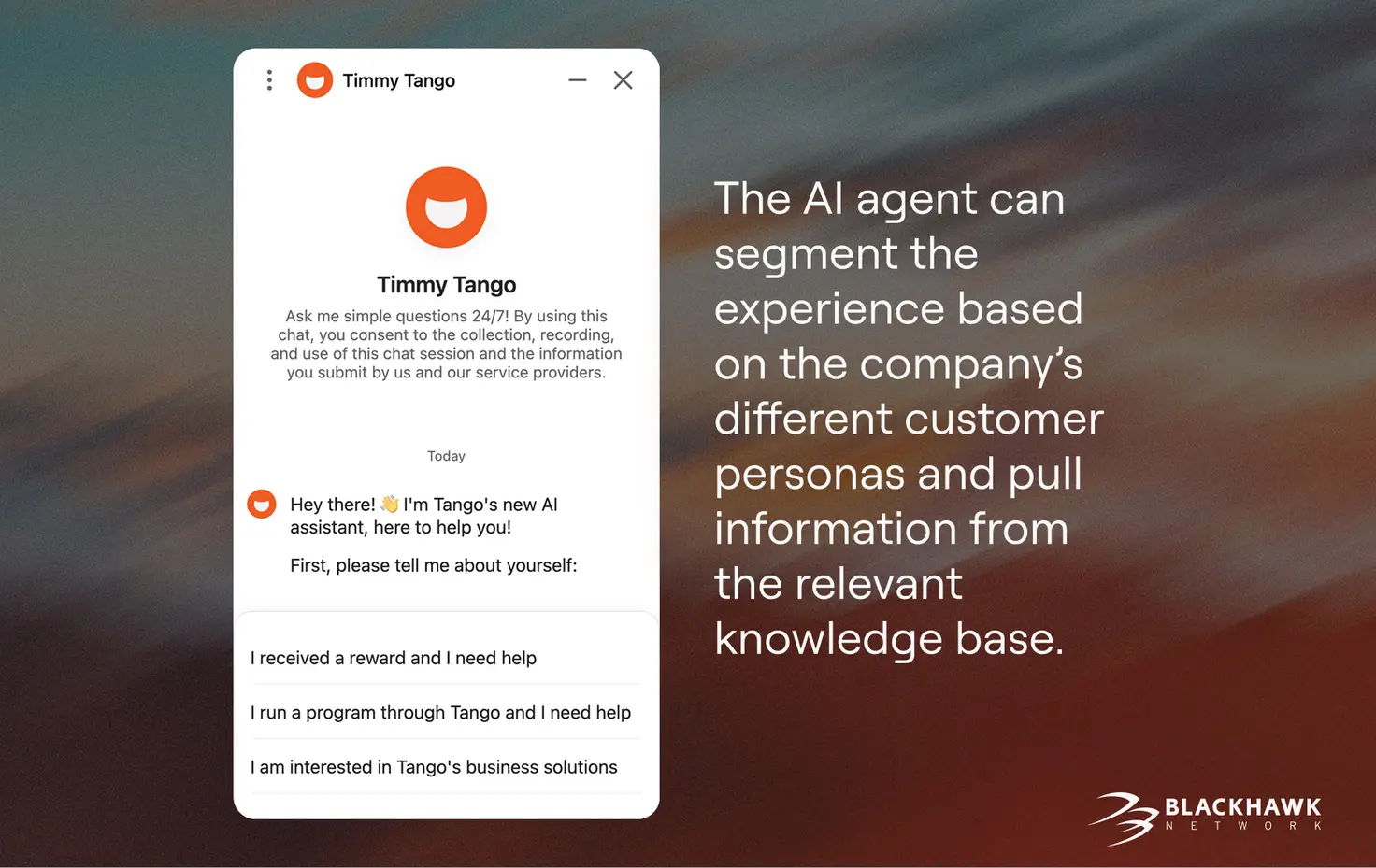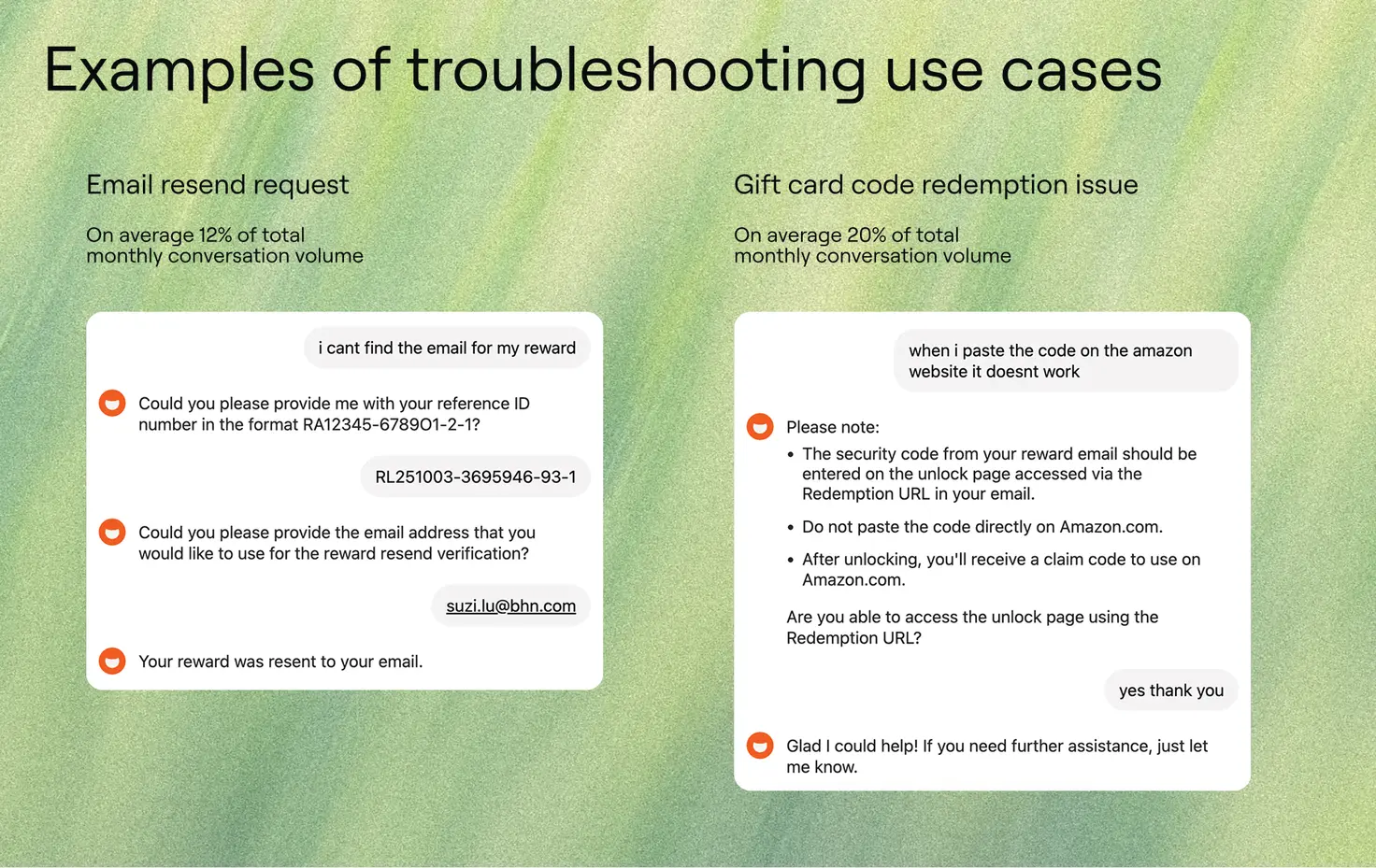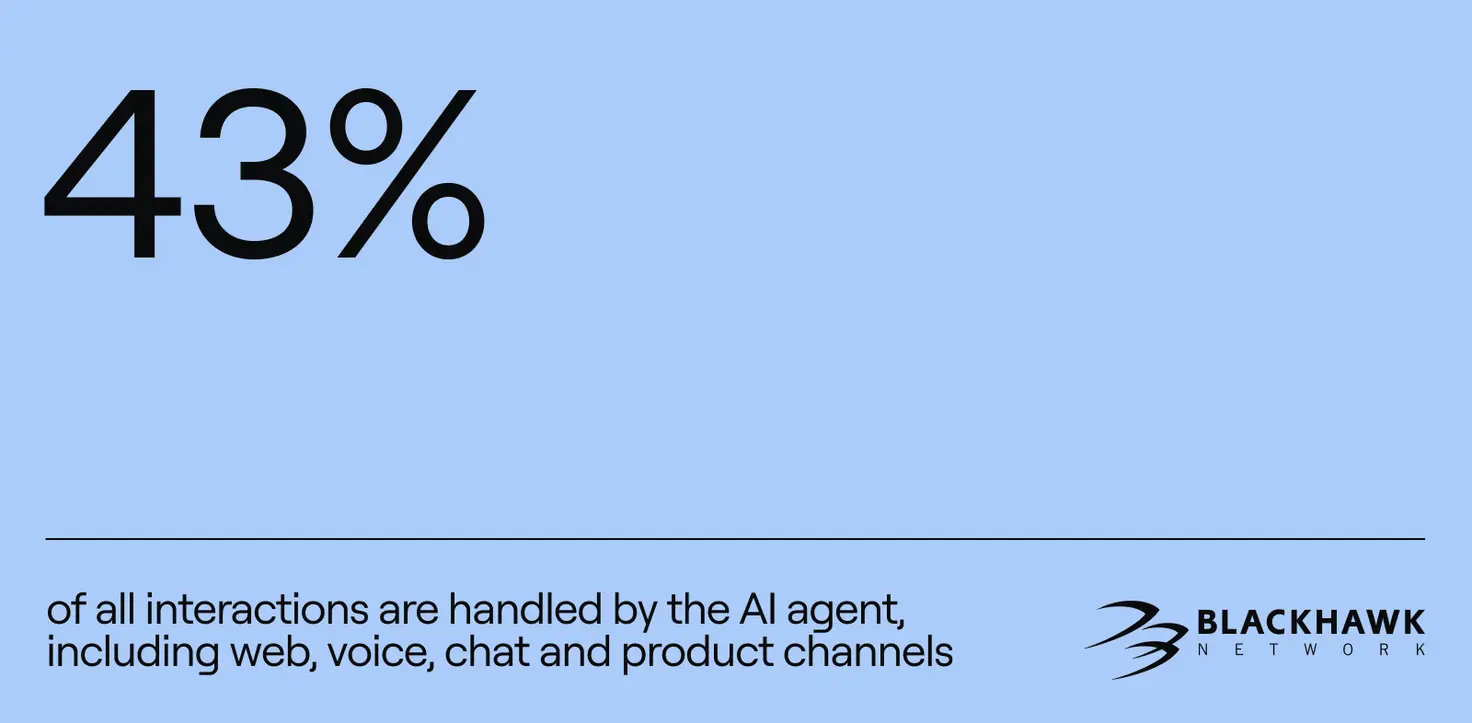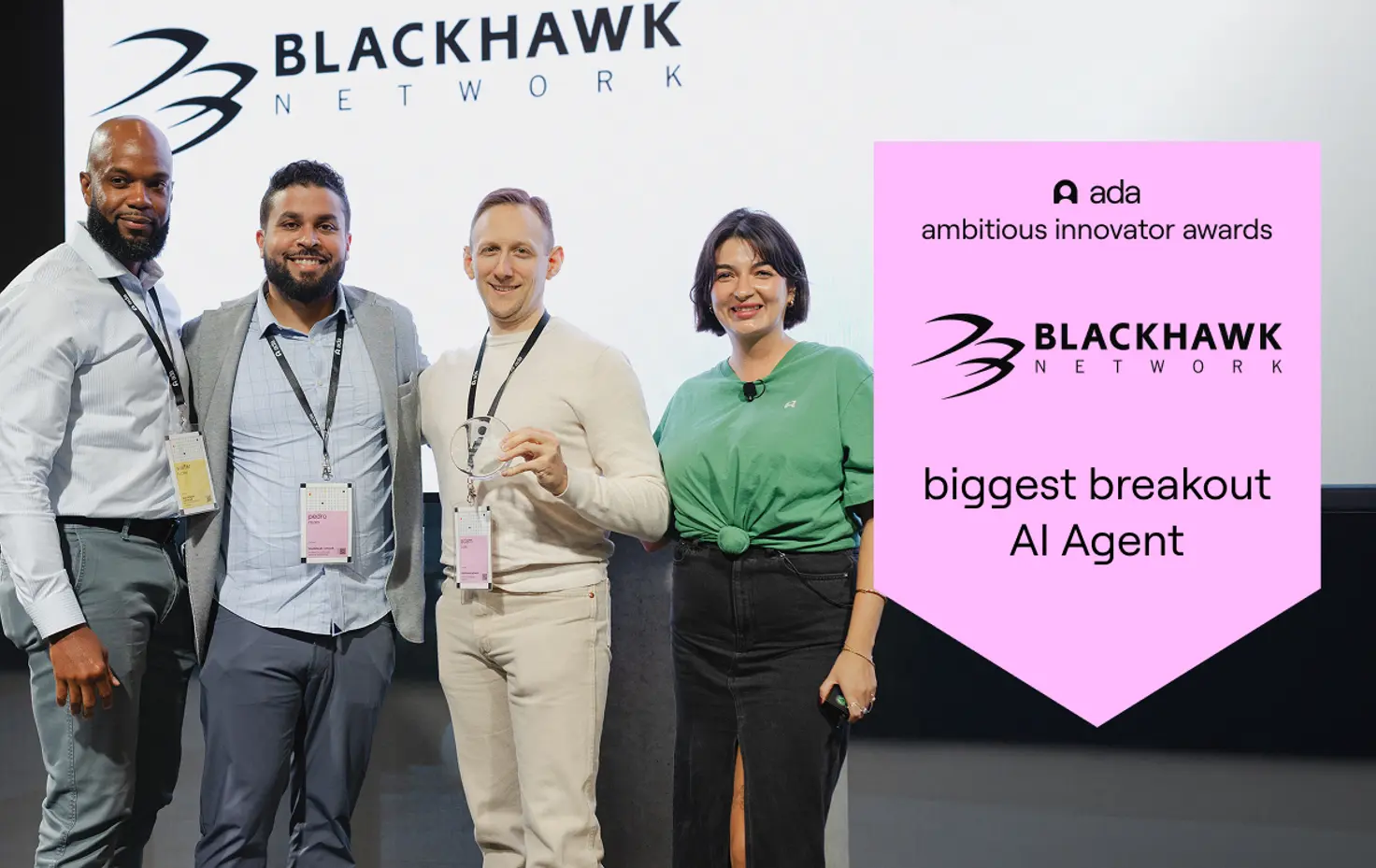
Blackhawk Network
- Upskilled human agentsto AI collaborators
- Expanded automationacross all brands and channels
- Automatically resolvinghalf of all incoming customer inquires across all channels
How Blackhawk Network turned CX into a growth engine with Ada
Following its strategic acquisition of Tango Card , Blackhawk Network has spent the past year at the forefront of AI customer service with an AI agent. What started with scripted automation has grown into a mature, generative AI Customer Experience (ACX) program—one that’s reshaping how the company thinks about scale, efficiency, and customer care.
"At BHN, we’re deeply committed to delivering exceptional customer experiences — it’s at the heart of everything we do. The emergence of agentic AI is not just enhancing how we think about customer engagement and support; it’s completely transforming it."


This case study explores their remarkable transformation across five key dimensions of AI maturity: team structure, knowledge management, company engagement, systems and integrations, and scale and coverage.
From upskilling agents into AI collaborators to deploying automation across brands and channels, Blackhawk Network is proving what’s possible when customer service becomes a strategic engine for growth.

Team structure: from frontline support to strategic AI champions
Past: traditional support, limited structure
Prior to joining Blackhawk Network, and before adopting Ada, Tango Card ran a conventional call center model. Agents handled customer and recipient inquiries via phone and email, structured as a flat org where supervisors handled both people management and every escalation.
With the introduction of the scripted Ada chatbot, an evolution began. Automation helped reduce volume by resolving common inquiries, allowing the team to remain lean. With fewer repetitive tickets, agents gained time to focus on higher-value work like analyzing product feedback or learning new skills. Supervisors were gradually pulled out of the weeds and into more strategic leadership roles.
This shift also prompted the creation of two foundational roles: Content Specialist and QA Specialist. These positions focused on maintaining Help Center content and auditing both bot and agent interactions—laying the groundwork for a more AI-driven future while ensuring people are appropriately in the loop and adding value.
Present: specialization, upskilling, and strategic collaboration
The switch to generative Ada supercharged the transformation. No longer required to know every product front-to-back, agents were now assigned to specific product specialties. This change dramatically reduced cognitive load and helped level up frontline staff into subject matter experts, capable of advising on AI content and identifying areas for optimization.
Critically, agents now review and critique AI conversations—a skill once reserved for QA roles. It’s not just support; it’s mentorship, coaching, and collaboration with the AI agent itself.
“Generative AI changed how we use the agents’ strengths. We’re offering to upskill them, which doesn’t only help the business, but their careers as well. By combining their domain expertise and AI management skills, they can make the experience that much better for customers.”


New roles like Product Specialists emerged, acting as consultants on trends and contact drivers. These agents don’t just react to customer issues—they influence improvements in product, process, and technology. Hosting Weekly Trend Overviews offers them a seat at the table, alongside leaders from other teams such as Engineering, Business Systems, and Product.
With an AI agent on staff, the team now spends less time solving repetitive problems and more time solving for the business.
future: scaling ACX excellence
Now part of the broader Blackhawk Network ecosystem, the support team is scaling fast. The plan? Specialize content managers from the Knowledge Base Management team as domain experts across BHN’s diverse lines of business—from B2C commerce to incentive platforms. These content managers will act as strategic connectors, enabling Ada to serve more audiences, with greater accuracy and depth.
Blackhawk is also defining a new role: AI Certified Agents. These agents will continuously test use cases in self-service channels, helping train the AI model while reinforcing skill-building within the team. It's a virtuous cycle—stronger agents make a smarter AI agent, and a smarter AI agent creates space for deeper agent development.
To support this evolution, BHN has partnered with Udemy to upskill staff in Data & Analytics, Six Sigma, and ITIL 4, and is building sociograms and agile calendars to drive faster onboarding and role clarity.
At Blackhawk Network, the AI agent isn’t just transforming customer support. It’s redefining what a modern support team can be: strategic, scalable, and deeply human.
“We’re only at the beginning of this transformation, yet the potential is already undeniable. Agentic AI is poised to redefine how support is delivered—for us at BHN and for our customers—for good.”


Knowledge management: from content chores to strategic enablement
Past: scrappy and centralized
In the early days, knowledge management at Blackhawk Network was mostly ad hoc: content updates were managed by support leaders or hybrid agents whenever time allowed. It was a reactive approach, driven by necessity rather than design, but it kept the lights on and laid the groundwork for more structured operations down the line.
Still, the team was forward-thinking. They began folding knowledge base performance into their monthly Support Trends meetings, using real customer data and scripted Ada chatbot interactions to surface improvement areas. This early feedback loop was the first step toward a more dynamic, insight-driven content strategy.
Present: purpose-built and AI-informed
After switching to generative Ada and as the ACX program matured, so did the approach to knowledge management. Today, a dedicated team of content owners partners with subject matter experts to build, maintain, and continuously optimize the knowledge base. Their goal is no longer just to inform, it’s to enable the AI agent to perform.
Content is now created with the AI agent in mind. That means carefully crafted, tested, and monitored articles that not only answer questions, but do so in a way that’s optimized for generative AI. This shift has significantly reduced the need for frequent maintenance. Instead of scrambling to patch content gaps, the team is now focused on proactive monitoring and strategic refinement.

The team’s work also supports a broader ACX ecosystem, informing new AI agent actions, guiding training for AI Certified Agents, and closing the loop between product feedback and customer insights.
Future: scaled for impact
Looking ahead, Blackhawk Network is preparing to take knowledge management to the next level. With multiple business lines and use cases across the broader BHN ecosystem, the plan is to specialize content managers by domain, creating deep expertise across commerce, incentives, and B2C offerings.
“Our goal is to build a network of content strategists who don’t just write articles, but act as connective tissue across teams—working closely with agents, product owners, and data analysts to shape how the AI agent learns and delivers value.”


Eventually, Blackhawk expects to stand up a dedicated AI Knowledge Base Manager role to lead this next phase, someone who can ensure content keeps pace with Ada’s expanding reach and the business’s evolving needs.
The shift is clear: knowledge is no longer a static resource. At Blackhawk Network, it’s a living, evolving asset—fueling automation, accelerating performance, and helping the AI agent and its human teammates shine.
Company engagement: turning internal wins into enterprise-wide momentum
Past: metrics in a silo
In scripted Ada days, Tango Card’s success metrics were narrow but effective. The focus was on two things: engagement rate and containment rate. These numbers helped demonstrate early value and justify the use of automation, with containment reaching over 70% within the first few months.
At the time, reporting responsibilities fell to a small group: the support director, supervisors, and a content specialist. The reports helped them make internal improvements and pinpoint areas where the scripted Ada chatbot wasn’t handing off effectively. But these insights largely stayed within the support team. Outside of their org, few people saw what was happening—or the potential.
Present: expanded metrics, growing visibility
As BHN moved to generative Ada, their view, and their audience, grew. Today, ACX performance is measured using a more holistic set of metrics:
- Automated resolution rates
- Containment and handoff rates
- CSAT scores
- Contact driver groupings
This shift has helped move the narrative from “bot efficiency” to business impact, especially as Ada began helping the company realize tangible cost savings.
Reporting today is a collaborative effort across multiple teams, including Business Systems and Content Management, depending on the product owner. While it’s not yet fully centralized, the organization is making clear strides toward aligning stakeholders and solidifying ownership of ACX reporting.

Weekly roadmap reviews continue to be a key forum for sharing updates, with leadership from Engineering, Product, and Support at the table. Since the acquisition by Blackhawk Network, these sessions have become even more important—connecting AI performance to broader organizational goals like cost efficiency, scalability, and innovation.
“We're just tapping into what's important to senior leadership and how we can bridge the gap between ACX and business goals,” Walter explains. “We find different areas of the organization where we can kind of poke and say, ‘hey, here's a great example of how AI can solve this or that for you.’ So we're actually starting to reach out now more and more about what else we can do in this space.”
And momentum is building. Internal demos and word of mouth have piqued the interest of other teams across the company. In fact, BHN leadership had already been exploring generative AI vendors when the Tango team shared their success story. Their response? “We’ve already got something great—let’s build on it.”
Future: scaling advocacy across the enterprise
With more lines of business under the Blackhawk Network umbrella, the ACX team sees massive potential for expansion. The next chapter is all about scaling evangelism and proving value across the enterprise.
That means working closely with stakeholders in each business unit to identify high-impact use cases where Ada can be introduced, optimized, or expanded. It also means continuing to tailor reporting to what matters most to senior leadership—cost savings, automation ROI, and customer experience quality.
As Walter puts it, “Our plan is to keep finding those small, high-impact wins—use cases that show how Ada can drive value across different areas of the business.”
The vision is clear: Company engagement isn’t just about internal communication, it’s about building enterprise-wide momentum. And at Blackhawk Network, that momentum is already in motion.
"This evolution goes far beyond operational efficiencies like automation, cost savings, or always-on, real-time support. It’s about creating truly personalized, digital-first experiences at scale—empowering our customers and end-users to interact with us in ways that feel intuitive, seamless, and fully embedded in their product journey."


Systems and integrations: unlocking AI agent skills
Past: flexible, but heavy on maintenance
In the scripted Ada days, the support team pushed boundaries with powerful integrations. At the time, this approach was a major step forward, enabling automated answers that tapped into core business systems. But as the team scaled, each new use case required a manually built path, leading to a growing web of answers that demanded significant effort to maintain.
“The bot wasn’t limited,” says Andrew Amodeo, Senior Business Systems Analyst at Blackhawk Network. “It gave us tremendous flexibility and control. But that control came at a cost: hours of upkeep, repetition, and overhead.”
Despite the effort, this early work laid the foundation for a highly customized support experience. Still, the need for a more scalable, less resource-intensive approach was clear.
Present: easier Integrations, greater impact
Generative Ada was a gamechanger. Blackhawk Network can now set up single API actions that are reusable across multiple contexts—cutting down dramatically on repetitive admin work. Once the back-end integrations are in place, content managers and support agents can take the reins, giving the Business Systems team space to focus on innovation, not maintenance.
The result? A dramatically more capable AI agent:
- User Lookups: Greet logged-in customers by name and streamline handoffs by identifying who they are upfront.
- Order Info Retrieval: Provide product-specific responses to recipients—without extra back-and-forth or guesswork.
- Smart Routing: Automatically route cases based on user identity, removing the need for clunky menu prompts.
- Order Resends: Instantly resend digital rewards, saving agents hours of manual work.
- Sales Support: Let prospects book meetings directly with reps via Calendly.
- Live Chat Handoffs: Seamlessly connect customers to the right human agents when needed.

And it’s not just actions—knowledge is integrated too. The AI agent pulls in content from two knowledge bases and their marketing website’s CMS via Ada’s Knowledge API. The result is a streamlined, multi-source content ecosystem that serves customers, recipients, and prospects—without piling on work for the content team.
Future: scaling smart integrations across brands
The path forward is clear: with systems already in place and reusable actions now standard, Blackhawk Network is well-positioned to scale integrations across more brands, channels, and use cases.
Whether it’s deeper CRM connections, new use cases in Voice and Email, or AI workflows in emerging business lines, the foundation is there. BHN’s strategy has evolved from building one-off answers to building long-term automation infrastructure—and that shift is powering faster service, smarter support, and a better experience for everyone involved.
Moving from declarative scripting to Generative AI within Ada’s ecosystem has been a major evolution for us,” says Adam Cole, Senior Director, Global Head of Business Systems & Architecture at Blackhawk Network. “Where before there was high overhead requiring direct continual involvement and maintenance across the board including technical staff, now we can enable and empower our experts in Support to continuously guide the AI agent’s framing with data-driven feedback loops to generate the best answers across our multiple customer personas, brands, channels, and digital properties. We can configure & curate in one spot and deploy everywhere. Less input, better output.”
Scale and coverage: expanding across channels, brands, and use cases
Past: starting with the basics
In its early days, the scripted Ada bot at Blackhawk Network (then Tango Card) was deployed on a limited set of channels—primarily Help Centers and in-product portals. While it served as an early gateway to self-service, its reach was relatively narrow. Still, it laid a strong foundation: proving that automation could deflect meaningful volume and free up agents for more strategic work.
Present: a multi-channel AI experience
Today, the generative AI agent has extended its footprint. It now operates across Help Centers, in-product portals, and Voice, marking a significant leap in both functionality and accessibility. This expansion means customers can interact with the AI agent in more ways—and at more points in their journey.
The team is also using generative capabilities to personalize experiences across segments, streamlining the journey for customers, recipients, and prospects alike. The move to multi-channel coverage has enabled smarter handoffs, more targeted responses, and faster resolutions.

Future: broadening reach, deepening impact
Looking ahead, Blackhawk Network has ambitious plans to scale further. Next on the roadmap? Email and additional Voice capabilities, with a strong focus on increasing deflection in channels that traditionally drain agent bandwidth.
“BHN is really excited about Voice and Email,” says Pedro Reyes, Senior Director of Customer and Account Management Services. “Being able to optimize the experience for the customer while increasing deflection on use cases that would not stimulate the problem-solving abilities of our live staff.”
Beyond channels, BHN plans to deploy the AI agent across more brands, including Giftcards.com and CashStar.com. This expansion is not just about scale—it’s about serving complex, regulated, and global customer needs with the same consistency and intelligence.
One area of particular interest is dispute handling. BHN is exploring how Ada can initiate resolution processes by gathering key information upfront—cutting down on 30-minute phone calls and streamlining compliance-heavy interactions into guided, AI flows.
As BHN’s global footprint grows, the challenge is no longer proving what automation can do. It’s scaling it with purpose. Across products, geographies, and personas, Ada is poised to become the first point of contact—and the most efficient one—for millions of customers worldwide.
